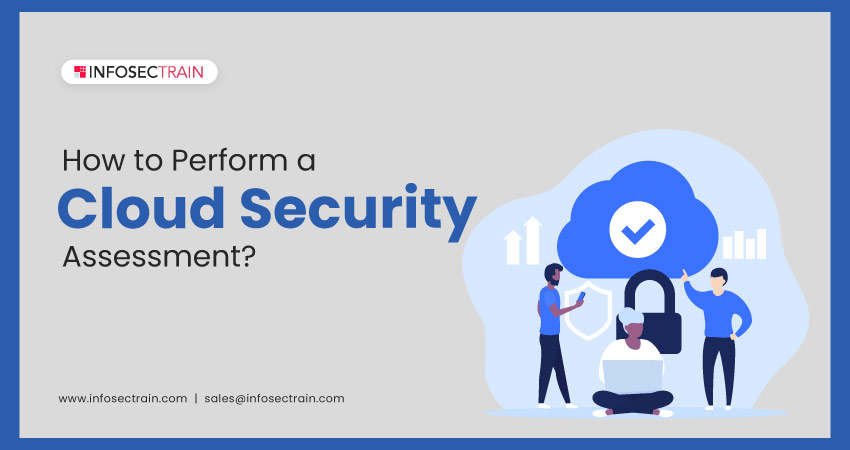How to Perform a Cloud Security Assessment?

What is Cloud Security Assessment?
A cloud security assessment evaluates the security of cloud computing infrastructure, services, applications, and data to identify potential risks and vulnerabilities. It involves using various security testing methods and tools to assess the security posture of cloud systems and determine if the security controls effectively protect against unauthorized access, data breaches, and other security threats. Internal security teams or third-party security providers can conduct cloud security assessments. The assessment can be done on a one-time basis or as part of an ongoing monitoring and testing program to ensure the continuous security of cloud systems.
An assessment of cloud security typically focuses on the following key areas:
- Data security: Ensuring that data stored in the cloud is protected against unauthorized access, loss, theft, or misuse. Security includes encryption, access controls, and other precautions to guarantee that only authorized users access data.
- Identity and access management: Ensuring that users are authenticated and authorized to access resources and data in the cloud environment. This includes using robust passwords, multi-factor authentication, and access controls to guarantee that only authorized individuals can access resources.
- Compliance: Assuring that the cloud environment complies with legal requirements and industry standards, including PCI-DSS, HIPAA, and GDPR. This includes regular audits and assessments to ensure that the cloud environment complies with relevant standards.
- Network security: Ensuring that the cloud environment is protected against network-based attacks, such as Distributed Denial of Service (DDoS) attacks, by implementing firewalls, intrusion detection and prevention systems, and other security measures.
- Application security: Ensuring that applications hosted in the cloud are secure against attacks such as cross-site scripting (XSS) and SQL injection. This includes implementing secure coding practices, vulnerability scanning, and penetration testing.
- Disaster recovery and business continuity: Ensuring that the cloud environment can recover from disasters, such as natural disasters, cyberattacks, or human errors. This includes implementing backup and recovery solutions and disaster recovery plans to ensure business operations can continue during an interruption.
Benefits of a Cloud Security Assessment
There are several benefits of conducting a cloud security assessment, including:
- Identification of security vulnerabilities: A cloud security assessment can help identify potential vulnerabilities in the cloud environment, including misconfigurations, access control issues, and other security gaps. By identifying these vulnerabilities, organizations can take steps to address them and reduce the risk of a security breach.
- Compliance with regulations and standards: Many industries and regulatory bodies have specific security requirements for cloud environments. A cloud security assessment can help identify areas where an organization may not comply with these requirements, allowing them to take action to address any compliance gaps.
- Improved risk management: A cloud security assessment can provide organizations with a better understanding of their overall security posture, allowing them to prioritize security investments and strengthen risk management strategies.
- Increased confidence in the cloud environment: By conducting a cloud security assessment, organizations can demonstrate to customers, partners, and other stakeholders that they are taking security seriously and are committed to protecting sensitive data in the cloud environment.
- Enhanced business continuity: A cloud security assessment can help identify weaknesses in disaster recovery and business continuity plans, allowing organizations to improve their ability to recover from a security breach or other interruption.
Key Steps to Performing a Cloud Security Assessment
Performing a cloud security assessment involves several key steps, including:
- Define the scope: Define the scope of the evaluation, including which cloud services and applications will be included, the types of data being kept or processed, and the regulatory requirements that must be taken into account.
- Identify risks and threats: Identify potential risks and threats to the cloud environment, including unauthorized access, data breaches, and denial of service attacks. Consider both internal and external threats and determine each threat’s likelihood and potential impact.
- Evaluate existing controls: Evaluate the effectiveness of existing security controls, including access controls, data encryption, network security, and application security measures. Identify any gaps or weaknesses in the existing controls that may need to be addressed.
- Test the environment: Conduct penetration testing and vulnerability assessments to identify any security vulnerabilities or weaknesses that may have been missed during the initial risk assessment. Use tools like port scanners, vulnerability scanners, and penetration testing frameworks to test the cloud environment’s security.
- Analyze results: Analyze the assessment results to identify any security gaps or weaknesses that must be addressed. Prioritize the identified issues based on each issue’s likelihood and potential impact and determine appropriate actions to address each identified gap.
- Develop a remediation plan: Develop a remediation plan that outlines the actions needed to address the identified security gaps or weaknesses. Assign responsibilities for implementing the plan and establish a timeline for completion.
- Monitor and maintain: Monitor the cloud environment continuously to ensure that security controls remain effective and to identify new risks or threats as they emerge. Implement a process for regularly reviewing and updating the security posture of the cloud environment.
Cloud Computing with InfosecTrain
At a time when organizations are migrating to the cloud in large numbers, upgrading your tech skills can be the beginning of a prosperous IT career. Whether you want to get into this field or move up in it, a cloud certification training like Amazon Cloud Practitioner, AWS Certified Solutions Architect – Associate, and AZ-900 – Microsoft Azure Fundamentals from a reputable training provider like InfosecTrain will teach you the skills you require to get started in the cloud computing field.




 1800-843-7890 (India)
1800-843-7890 (India) 
